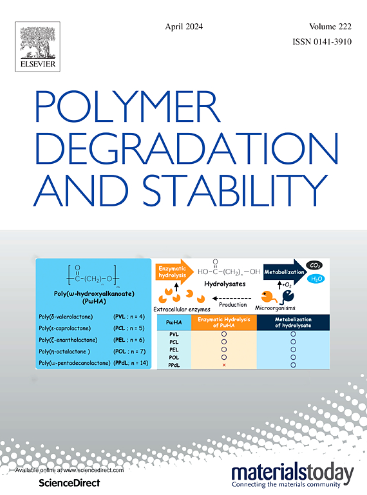Performance comparison and lifespan assessment of naturally and artificially chalked silicone rubber for composite insulators
IF 6.3
2区 化学
Q1 POLYMER SCIENCE
引用次数: 0
Abstract
Chalking is a typical manifestation of high-temperature vulcanized silicone rubber (HTV-SR) deterioration for composite insulators. Previous studies have proposed an efficient artificial chalking method based on tetramethylammonium hydroxide (TMAH), but the quantified equivalence between artificial and natural chalking, particularly in terms of electrical properties, remains underexplored. In this paper, 5 naturally chalked (NC) samples with different lifespans and 5 artificially chalked (AC) samples with different TMAH concentrations are prepared. Then surface morphology, structure, mechanical and electrical properties of chalked samples are methodically characterized. The results indicate that the overall performance of the two kinds of chalking surfaces is similar, but AC samples treated with high TMAH concentration exhibits severe chalking. Besides, the NC process is driven by both filler precipitation and oxidative crosslink, whereas the AC process lacks internal oxidation. Further analysis based on quantum chemistry calculations reveals the silanol produced during chalking has a narrow-forbidden gap and deep traps, which degrades the electrical properties. Finally, a lifespan assessment method with 8 chalking indexes is constructed and the optimal Ridge Regression model is selected to comprehensively assess lifespans of AC samples. This study explores the chalking characteristics of NC samples, and also offers manufacturers an efficient way to evaluate the chalking resistance of new HTV-SR.
求助全文
约1分钟内获得全文
求助全文
来源期刊

Polymer Degradation and Stability
化学-高分子科学
CiteScore
10.10
自引率
10.20%
发文量
325
审稿时长
23 days
期刊介绍:
Polymer Degradation and Stability deals with the degradation reactions and their control which are a major preoccupation of practitioners of the many and diverse aspects of modern polymer technology.
Deteriorative reactions occur during processing, when polymers are subjected to heat, oxygen and mechanical stress, and during the useful life of the materials when oxygen and sunlight are the most important degradative agencies. In more specialised applications, degradation may be induced by high energy radiation, ozone, atmospheric pollutants, mechanical stress, biological action, hydrolysis and many other influences. The mechanisms of these reactions and stabilisation processes must be understood if the technology and application of polymers are to continue to advance. The reporting of investigations of this kind is therefore a major function of this journal.
However there are also new developments in polymer technology in which degradation processes find positive applications. For example, photodegradable plastics are now available, the recycling of polymeric products will become increasingly important, degradation and combustion studies are involved in the definition of the fire hazards which are associated with polymeric materials and the microelectronics industry is vitally dependent upon polymer degradation in the manufacture of its circuitry. Polymer properties may also be improved by processes like curing and grafting, the chemistry of which can be closely related to that which causes physical deterioration in other circumstances.
 求助内容:
求助内容: 应助结果提醒方式:
应助结果提醒方式:


